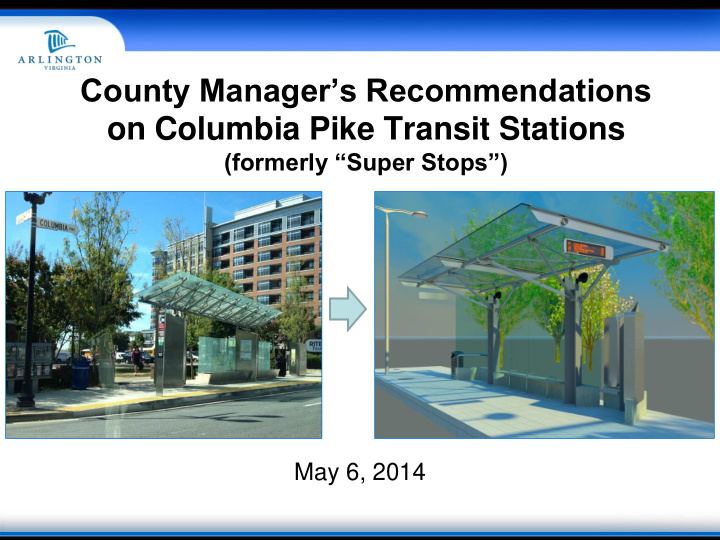



County Manager’s Recommendations on Columbia Pike Transit Stations (formerly “Super Stops”) May 6, 2014
Overview We heard the community We developed a better design We substantially reduced costs We will take over management of the project from WMATA and deliver it effectively and efficiently We will continue to leverage federal and state funding 2
Program Funding 2013 CIP = $20.9 million 2015 CIP = $12.4 million (24 stations) (23 stations) Local - G.O. Bond = 5% $1 million Local - G.O. Bond = 6% $800,000 Federal = 38% Local - TCF= 33% Local - TCF= 28% $8 million $6.8 million Federal = 52% $3.5 million $6.4 million State = 24% State = 14% $5.1 million $1.7 million Note: Local - TCF is Arlington County’s Transportation Capital Fund, which is dedicated 3 transportation revenue from the commercial and industrial real estate tax.
Vision for the Pike • Create an improved, walkable “Main Street” • Neighborhoods, including a town center, linked by enhanced transit and wider sidewalks Transform the corridor from an Vibrant, pedestrian-friendly, “aging auto -oriented, suburban, into a “Main Street” destination. commercial strip”
Chronology Integrating Land Use and Transportation on the Pike LAND USE 2002 2004 2006 2008 2010 2012 2014 2000 TRANSPORTATION 5
Transit Ridership on the Pike Average Weekday Ridership (Boardings) 20,000 18,000 16,000 14,000 12,000 10,000 8,000 Pike Ride implemented in FY 2004 6,000 4,000 2,000 0 FY FY FY FY FY FY FY FY FY FY FY FY 2003 2004 2005 2006 2007 2008 2009 2010 2011 2012 2013 2014* * FY 2014 ridership is estimated based on actual for months to date and forecast for year remaining. 6
Types of Stops / Stations Typical Daily Ridership (Boardings): Up to 40 40 to 100+ 250 to 1000+ 1000+ Cost and ridership information based on survey of projects in the industry. 7
Transit Stations in Other Cities Eugene, Oregon – BRT Hampton Roads – LRT $445,000 $762,000 Charlotte, NC – LRT Grand Rapids, MI BRT $757,000 $662,000 8
Status of Review Completed: 1. Community feedback 2. Design review Still underway: 3. Performance and financial review 9
Community Feedback Goal: Listen to what the public had to say about the prototype, to inform the design review. Surveyed actual users and residents 732 completed surveys Five stakeholder group Included 515 meetings users of the 50 emails reviewed Walter Reed station 10
Results of Community Feedback A number of users and residents commented that the cost was too high. 11
Design Review Included: – Review of community feedback – Analysis of prototype design and function – Technical working group of County staff from multiple disciplines – Multiple alternative designs – Reviewed life cycle costs of final alternatives 12
Results of Design Review What we improved: Better canopy coverage Better pedestrian circulation Improved ADA accessibility Better seating “Kit of parts” design (modular) What we kept: Passenger amenities Real-time information Lighting Design aesthetics 13
Transit Stations - Optimized Design 14
Transit Station Design Features Better canopy coverage with lighting Better seating Real-time Improved information accessibility displays 15
Comparison of Features Recommended Walter Reed Improvement Transit Station Prototype from Prototype (Standard size) Larger and 243 295 Canopy coverage (sq. ft.) lower canopy with reduced +- 13 +- 10 Canopy height (feet) angle = Improved weather 10 1.5 Canopy angle (degrees) protection Increased 4 covered 6 covered Seating capacity (persons) covered 3 uncovered seating 25 (+ 2 Increased & Covered standing capacity +- 13 handicap more ADA (persons) accessible spaces) 16
How We Cut Costs Simplified the design – Modular, flexible – can be Cheaper to scaled up or down build – Standardized components – Less structure, less steel Cheaper to maintain – Eliminated ice melt system – Scaled program to ridership 17
Cost Estimate Transit Station – Optimized Design conceptual cost estimate Standard size Construction, includes: Canopy, structure, foundation Amenities – benches, signs, lighting, real- $361,000 * time information signs, landscaping Site clearing, utility relocation, electrical Site design and project management $108,000 Total $469,000 * Construction cost includes a 30 percent contingency, typical for a concept design. 18
Construction Cost Breakdown Estimated Construction Cost (Standard size): $361,000 Structure: $192,000 Supporting infrastructure: $169,000 19
Transit Stations Program Station Size Estimated Cost* # of Stations Total Cost Standard $469,000 9 $4.2 M Single $362,000 8 $2.9 M Constrained $397,000 2 $0.8 M Extended $672,000 4 $2.7 M (Double Standard) Subtotal $10.6 M Contingency $1.8 M Program Total 23 $12.4 M * Each estimate includes site design, project management and construction costs. 20
Program Funding 2013 CIP = $20.9 million 2015 CIP = $12.4 million (24 stations) (23 stations) Local - G.O. Bond = 5% $1 million Local - G.O. Bond = 6% $800,000 Federal = 38% Local - TCF= 33% Local - TCF= 28% $8 million $6.8 million Federal = 52% $3.5 million $6.4 million State = 24% State = 14% $5.1 million $1.7 million Note: Local - TCF is Arlington County’s Transportation Capital Fund, which is dedicated 21 transportation revenue from the commercial and industrial real estate tax.
Summary We have: Cut standard-size station cost significantly Reduced program costs by 40% Developed a better design that shelters more people Taken over project management Incorporated lessons learned Stayed true to the goal of providing great transit for the Pike 22
Next Steps 1. Work with WMATA to complete performance and financial review and report results 2. Develop phased plan for building remaining 23 transit stations 3. Design and construct next eight transit stations • Consult community stakeholder groups during design 23
Columbia Pike Transit Stations For more information: www.columbiapikeva.us/transit-stations/ Includes summary report and community process and design review reports. 24
Recommend
More recommend